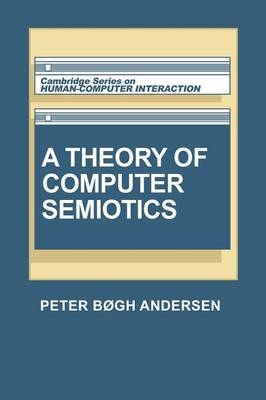
A Theory of Computer Semiotics
Semiotic Approaches to Construction and Assessment of Computer Systems
Seiten
1991
Cambridge University Press (Verlag)
978-0-521-39336-2 (ISBN)
Cambridge University Press (Verlag)
978-0-521-39336-2 (ISBN)
This 1991 book, which is based on a course taught by the author and developed from 10 years' research, introduces basic traditional semiotic concepts and adapts them so that they become useful for analysing and designing computer systems and their interfaces.
Semiotics is the science of signs: graphical, such as pictures; verbal (writing or sounds); or others such as body gestures and clothes. Computer semiotics studies the special nature of computer-based signs and how they function in use. This 1991 book is based on ten years of empirical research on computer usage in work situations and contains material from a course taught by the author. It introduces basic traditional semiotic concepts and adapts them so that they become useful for analysing and designing computer systems in their symbolic context of work. It presents a novel approach to the subject, rich in examples, in that it is both theoretically systematic and practical. The author refers to and reinterprets techniques already used so that readers can deepen their understanding. In addition, it offers new techniques and a consistent perspective on computer systems that is particularly appropriate for new hardware and software (e.g. hypermedia) whose main functions are presentation and communication. This is a highly important work whose influence will be wide and longlasting.
Semiotics is the science of signs: graphical, such as pictures; verbal (writing or sounds); or others such as body gestures and clothes. Computer semiotics studies the special nature of computer-based signs and how they function in use. This 1991 book is based on ten years of empirical research on computer usage in work situations and contains material from a course taught by the author. It introduces basic traditional semiotic concepts and adapts them so that they become useful for analysing and designing computer systems in their symbolic context of work. It presents a novel approach to the subject, rich in examples, in that it is both theoretically systematic and practical. The author refers to and reinterprets techniques already used so that readers can deepen their understanding. In addition, it offers new techniques and a consistent perspective on computer systems that is particularly appropriate for new hardware and software (e.g. hypermedia) whose main functions are presentation and communication. This is a highly important work whose influence will be wide and longlasting.
Part I. Theory: 1. The structuralist heritage; 2. Adapting and extending structuralist methods; Part II. Computers: Introduction; 3. The basic means of expression; 4. Composite computer-based signs; Part III. Language, Work and Design: Introduction; 5. Language as interpretation: semantic fields in the postal giro; 6. Language as action: language games in the postal giro; 7. Task analysis: controlling control; References; Index.
| Erscheint lt. Verlag | 25.1.1991 |
|---|---|
| Reihe/Serie | Cambridge Series on Human-Computer Interaction |
| Verlagsort | Cambridge |
| Sprache | englisch |
| Maße | 180 x 254 mm |
| Gewicht | 918 g |
| Themenwelt | Informatik ► Software Entwicklung ► User Interfaces (HCI) |
| ISBN-10 | 0-521-39336-1 / 0521393361 |
| ISBN-13 | 978-0-521-39336-2 / 9780521393362 |
| Zustand | Neuware |
| Informationen gemäß Produktsicherheitsverordnung (GPSR) | |
| Haben Sie eine Frage zum Produkt? |
Mehr entdecken
aus dem Bereich
aus dem Bereich
Aus- und Weiterbildung nach iSAQB-Standard zum Certified Professional …
Buch | Hardcover (2023)
dpunkt Verlag
34,90 €
Mit traditionellen, aktuellen und zukünftigen Erfolgsfaktoren
Buch | Softcover (2018)
Franz Vahlen (Verlag)
29,80 €
Wissensverarbeitung - Neuronale Netze
Buch | Hardcover (2023)
Carl Hanser (Verlag)
34,99 €


